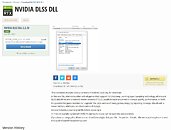Monday, July 5th 2021

TechPowerUp Hosts NVIDIA DLSS Client Libraries
TechPowerUp is hosting a repository of NVIDIA DLSS client libraries that game developers pack with their DLSS-compatible games. This library goes by the file name "nvngx_dlss.dll." Recent discussions on tech forums and Reddit revealed that the DLSS libraries, which are usually located in the game's installation folders, are user-swappable, meaning that one can replace their DLSS library file for a different version that enables a different set of features or potentially even image quality or performance improvements. So far people have shared these files through sites like Mega, which of course introduces a malware risk. That's why we decided to host these files ourselves, located in our Downloads section. We currently have 23 versions, all hand-verified to be the unmodified originals, ranging from 1.0.0 to 2.2.10. Click on the "show older versions" link below the "Download" button to list the other versions. We will keep adding to the collection as we come across more of these. Have something we don't? Comment below.
DOWNLOAD: NVIDIA DLSS DLL
DOWNLOAD: NVIDIA DLSS DLL

33 Comments on TechPowerUp Hosts NVIDIA DLSS Client Libraries
The FSR shaders just get integrated into the game's files like its own shaders.
he just provides d3d11.dll and gta5_fsr.ini thats it, yes he did modding in those to fit GTA V
And Thank you,
Made testing later versions easier.
No one would even need to go update the dll if the developers did this via the normal patching process. Obviously there is time needed for determining if there is a benefit to using a newer version (which has already been proven in multiple examples) and then validation that nothing broke due to API changes. It just seems that Nvidia needs to push developers to keep their DLSS versions up to date.
Although I agree, if you shipping a DLSS 2.0 game, those devs should 100% be spending the minimal amount of time needed to inject the new DLL, test it and patch the game with it - IF this is allowed after all.
aquinus must be having a bad day, this got weird
This begs the question of why this isn't also part of the inference process of DLSS across games where it checks several DLSS DLL configurations and picks the most optimal based on the game? If anything it's a hands off opportunity for Nvidia to do better with DLSS til they can start doing what I mentioned because they should be anyway.
Nvidia would be playing with fire by going after TMU over this matter and I'm pretty certain their fully aware of it. Worst case what is Nvidia going to do send them a cease and desist and TPU writes a article about it and maybe or maybe not holds a bit of a grudge and even if TPU doesn't directly many in the tech world certainly might have a fair degree of resentment towards Nvidia on the matter.
I can see where maybe it could be considered a grey area, but is it something Nvidia wants to concern itself with at this point in time!!? Instead of making DLSS more compelling they'd effectively be doing the exact opposite retroactively. It might stir developers backlash to flip to FSR and gamer's switching over to AMD it would almost be Seppuku of Nvidia to do so. I don't think the tech community as a whole would standby Nvidia doing so.
This thread is for what different it actually makes, technical details, etc.
Doubt it though.
the main issue is going to be that alot of the improvements people see are simply placebo, the dlss files are just runtimes, with the game itself setting the values, newer versions don't have any new inferenced data for a game to use its just new features that games can't use because they don't know exist or bug fixes(or new bugs).
What 2.0 doesn't require is for the inferencing model to be altered per game, all 2.0 games are inferenced through the same generalized model with the same retained datasets, so every new game that goes through the model further contributes to games down the line progressively improving the technology.Changing the DLL bundled with the game isn't increasing the known inferencing data, this is only possibly via NGX binary updates which can be published through GFE or as a Driver update.
- One Network for All Games and Applications - DLSS offers a generalized AI network that removes the need to train for each specific game or application.
The DLSS 1.0 model started each instance of each game at each resolution completely new without any former inferencing information at hand,Everything that 2.0 see's, it remembers and stores for potential future use, low and high resolution stills from the dlss 2.0 game are still introduced into the auto encoder so its still training on specific game data.
This removes and replaces the wrongly assumed Deterministic model that 1.0 had causing significant motion artifacts and blur
Also a good part of why 2.0 Training is faster than 1.0 and also capable of introducing detail that was never in the original image.
NVIDIA trains (creates) the network in their labs and ships the network to us in the DLSS DLL + evolutionary workarounds, tweaks and fixes